Solar FAQ
Does solar PV work in Ireland?
Yes! A typical solar PV system can save around 1,000 euro each year and is equivalent to planting around 50 trees. The total savings is based on two parts: (i) using PV electricity directly in your home to reduce bills (ii) exporting excess electricity to the grid. These values are obtained from the AirPV calculator and you can check the values for your own home.
Ireland has a similar climate to other EU countries but a much lower level of adoption. Less than 5% of homes in Ireland have solar PV compared with around 20% in the Netherlands.
Using the electricity in your home gives the best savings as it offsets high electricity costs (currently around 43 cents per kWh including VAT). Any electricity that you don’t use can be exported to the grid for around 21 cents per kWh (less than half as good as using the electricity yourself).
How much will it cost?
A typical system will cost around 7,500 euro after the grant has been applied. This is based on the latest average cost figures from the Sustainable Energy Authority of Ireland (SEAI) as seen for completed installations in Ireland.
However, the cost and quality can vary a lot depending on the installation company. It is recommended that a homeowner gets multiple quotes, use a trusted installer and goes with a design and PV system that is suited to their needs. Sounds tricky? Well AirPV aims to make this whole process easier and better value by providing a platform that connects homeowners with multiple installers. It is free to use and aims to provide a homeowner with the best experience when going solar. Sign up to get access to an interactive calculator and learn more about solar PV. The marketplace is coming soon where homeowners can connect with trusted installers.
What financial supports are available?
The government provides support in the form of a grant and by mandating that electricity suppliers pay for electricity that a homeowner exports.
The grant is up to 2,400 euro and offsets the initial cost of the PV system. To learn more about the PV grant, head over to the SEAI website.
As part of the Microgeneration Support Scheme (MSS), electricity suppliers are obliged to pay for the excess electricity that a homeowner exports from their PV system (or other renewable energy system). This export tariff is referred to as the Clean Export Guarantee (CEG). Suppliers are currently offering around 21 Ct/kWh for electricity that a homeowner exports to the grid. More information can be found on the government website.
What is a solar PV system?
A solar photovoltaic (PV) system converts sunlight into electricity. It typically consists of 5 - 10 PV modules on a roof that are connected to an inverter. The PV modules produce DC electricity and the inverter converts this into AC electricity that can either be used in the home or exported to the grid. This is not to be confused with ‘solar thermal’ which captures the sun’s energy to heat water. A solar thermal system does not produce electricity.

Source: Wikipedia
- PV modules produce DC electricity
- Inverter converts DC electricity to AC electricity
- The AC electricity can be used in home or exported to the grid
- A battery system can be used to store excess electricity that can be used later. This is instead of sending the excess electricity to the grid
- Your home’s smart meter measures how much electricity you use in your home and how much you export to the grid
The PV module is where the power comes from, it converts sunlight into electricity. ‘Photo’ comes from the Greek for light and ‘volt’ refers to electricity, together ‘photovoltaic’ technology is about converting light into electricity. More specifically, it is the conversion of photons to electrons.
PV modules work best in full sun where they will roughly produce the amount of power stated by the manufacturer. This is called the ‘peak power’ and is typically shown in kilowatts or kWp. So a 2 kWp system in full sun will produce around 2 kWp of power. PV modules also work in cloudy conditions but the power output will be much less.
The PV modules are normally fixed to the roof on top of a steel mounting structure. The PV modules are connected together by electrical cables that collect the power. The cabling connects to the inverter that is normally mounted below the PV modules on a wall inside the home. The inverter then converts the DC electricity into AC electricity that can be used by appliances in the home. Any excess AC electricity that the PV system produces can be exported to the grid.
Difference between solar thermal and solar PV?
A ‘solar PV’ system converts sunlight into electricity. While ‘solar thermal’ system uses the sun’s energy to heat water - it does not produce electricity. The two systems can look similar on a roof depending on the technology used.
A typical PV system is made up of 5 - 10 modules, where each module is around 1 x 2 m2 in size. The PV module produces DC electricity when exposed to light. A PV module is made up of individual solar cells that are normally crystalline silicon.
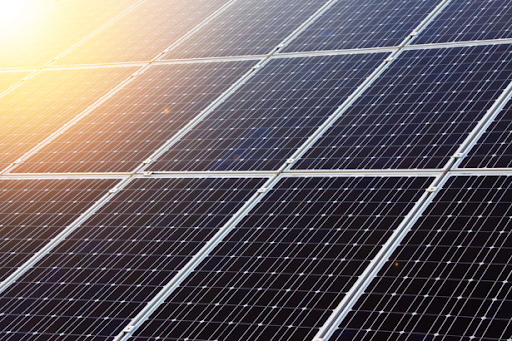
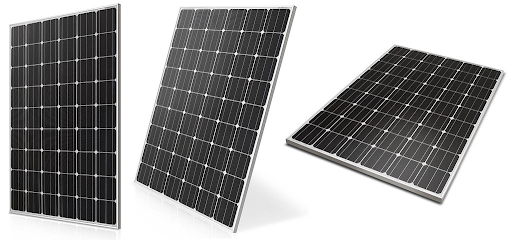
A solar thermal system uses thermal collectors, also known as hot-water collectors. The thermal collectors come in two common types: flat plate collectors and evacuated tube collectors.

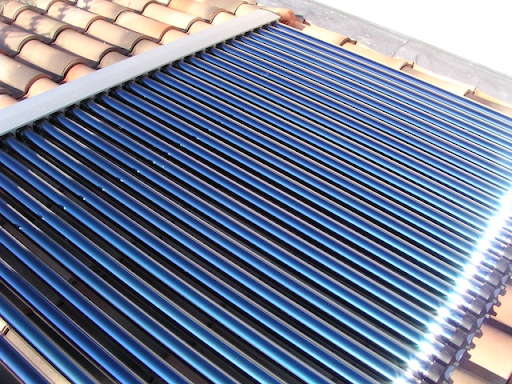
Cell, module, array or system?
Individual silicon solar cells absorb light and produce DC electricity. The cells commonly come in the form of squares with cutoff corners. Multiple silicon cells (say 60 or more) are connected together, covered in a glass sheet and wrapped in a metal case to form the overall PV module. Multiple PV modules are connected together on a roof to form what is called an ‘array’. The PV modules, inverter and other components are collectively referred to as the PV system.
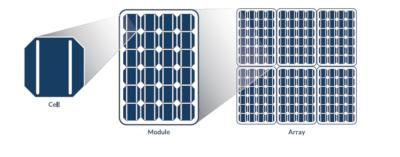

Source: Perovskite-info.
How are PV modules made?
The PV industry is currently dominated by devices based on crystalline silicon. The overall production process is summarised below. It basically consists of taking sand (silica or SiO2), removing the oxygen and purifying to get solar-grade silicon (simply referred to as polysilicon), then melting and cooling to form large blocks of crystalline silicon (ingots), slicing these into individual wafers and modifying into individual solar cells, which are finally combined into a PV module.
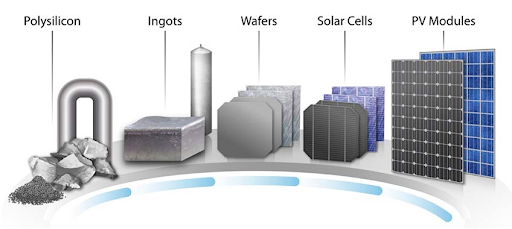
AirPV Calculator
The AirPV calculator is a helpful tool that shows the benefits of going solar and how much it will cost. The main results are the payback time, total savings and CO2 reduction. The calculator shows you how much it will cost to install a system after the grant is taken into account. It also provides an estimate of how much energy you will use in the home and how much will be exported to the grid.
The total savings is the amount of money a PV system will typically save each year. This consists of savings from using the PV electricity in your home (reduces bill) and savings from exporting excess electricity to the grid (and receiving an export tariff from your supplier). The payback time is simply the installation cost (after the grant) divided by the total savings each year. The CO2 reduction shows you how much CO2 is offset each year and how many trees a PV system is equivalent to. For more, see the tree math section of FAQ.
How does it work? The first step is to see how much energy a PV system on your home could produce. Google maps is used to check the location of your home. The EU's PVGIS database is then used to check how much energy can be produced by a PV system in your area. This takes into account the size of the system, the direction of your roof and the tilt angle of your roof. A shading factor is also included which reduces the amount of energy produced if there are shading objects like trees nearby. The amount of energy the PV sytem produces each year is shown next to 'total solar production'.
The second step is to see how much of the PV energy produced will be used in your home and how much energy will be exported to the grid. The energy used in your home reduces your electricity bill. Note that the reduction is based on offsetting the unit price for electricity that you pay during the day (as shown on your bill). Currently, this price is around 43 Ct/kWh. Any electricity not used in the home is exported to the grid. Your electricity supplier will pay you for each kWh of electricity exported and the typical value is around 21 Ct/kWh. Adding a battery can increase the amount of electricity used in the home but the battery itself costs more (increases the installation price).
How much energy you use in the home and how much you export to the grid depends on a number of factors. The main ones being how often people are at home and your appliances (dishwasher, washing machine etc). More energy will be used in the home if people are at home during the day and appliances are being used. However, if nobody is home during the day and no appliances are operating then most of the energy from your PV system will be exported to the grid. The calculator estimates how much energy will be used in the home and how much will be exported based on your monthly bill and how often people are at home. This is based on extensive research carried out by Loughborough University with Advance Further Energy Ltd and BRE National Solar Centre.
Tree math
kg CO2 eq. per year = kWh x (Electricity gCO2/kWH - PV gCO2/kWh)/1000
= kWh x (331 [1] - 40 [2])/1000
= kWh x 0.29
No. trees = ( kWh x 0.29 ) / 22 , 22 kg CO2/tree/year [3]
It is important to note that this is an indicative estimate. The PV gCO2/kWh is determined by a life-cycle assessment that depends on the carbon intensity of the energy used in each step. Basing the value on kWh also makes it dependent on PV generation in a particular location. Similarly, the carbon intensity of electricity is constantly changing - trending down as more renewable energy is used. Lastly, the carbon sequestration of trees is highly dependent on tree type, growing conditions and location.
Do I need planning permission?
Not anymore! In October 2022, the government introduced planning exemptions for rooftop solar. See announcement.